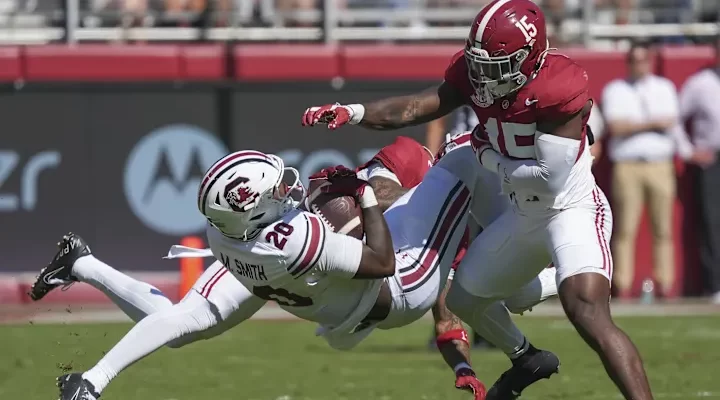Cracks in the Crimson Armor: Alabama Football’s Surprising Weak Spot Amid a Loaded Roster
In the world of college football, few programs carry the weight of expectations quite like the University of Alabama. Year after year, the Crimson Tide enter each season with a roster stacked with four- and five-star talent, a coaching staff as deep as any in the NFL, and a culture of excellence forged by more than a decade of dominance. Alabama doesn’t rebuild — it reloads. Yet, as the 2025 season approaches, there’s a growing realization among analysts, fans, and even those within the program that despite the depth, the experience, and the sheer talent up and down the roster, Alabama football may have a vulnerability at one critical position.
It’s a surprising development for a team known for leaving no weak link in its chain, and it’s even more surprising considering the hype surrounding this year’s squad. From a reloaded defensive line to a wide receiver corps that ranks among the best in the nation, Alabama has no shortage of playmakers. The offensive line is stout, the secondary is disciplined and fast, and the running back room is as dangerous as it’s been in years. But beneath the surface of this powerhouse roster lies a quiet concern — the quarterback position remains uncertain.
It’s not that Alabama lacks quarterbacks on paper. The room is full of high-ceiling athletes, many of whom were blue-chip recruits who turned down offers from every top-tier program in the country to wear the Crimson and White. But the problem isn’t about who is on the depth chart — it’s about what Alabama hasn’t yet seen from them. No quarterback in the current rotation has separated himself as a clear leader, and for a program built on precision, timing, and championship-level execution, that presents a real concern heading into the fall.
This situation is unusual, if not unprecedented, in the Nick Saban era. Since 2009, Alabama has enjoyed a parade of high-performing quarterbacks, from AJ McCarron’s cool efficiency to Tua Tagovailoa’s electric playmaking, and from Mac Jones’ pinpoint accuracy to Bryce Young’s Heisman-winning brilliance. Even Jalen Milroe, who led the team through a tumultuous but ultimately successful 2023 campaign, showed flashes of greatness. But with Milroe gone to the NFL and no heir apparent stepping up decisively during spring and early summer workouts, the most important position on the field remains unsettled.
The coaching staff, led by new offensive coordinator Zach Enos, has been tight-lipped about the competition, but sources close to the program suggest that the race remains wide open. The frontrunners include redshirt sophomore Ty Simpson, true freshman Eli Holstein, and junior transfer Marcus Davis, who arrived from a mid-tier Power Five program with hopes of revitalizing his career in Tuscaloosa. Each quarterback brings something different to the table. Simpson has the pedigree and the strongest arm in the group, Holstein is mature beyond his years and already a student of the playbook, and Davis brings game experience and mobility. Yet none of them has, to this point, convinced the coaching staff or the fanbase that they can be the one to lead Alabama through a playoff-caliber season.
This uncertainty isn’t just a theoretical problem. In the SEC, where the margin for error is razor-thin and every game can tilt a season’s outcome, having a steady and reliable quarterback is not optional — it’s essential. Especially for a team like Alabama that’s expected not just to compete but to contend. An unstable quarterback situation can impact everything from tempo and play calling to locker room leadership and in-game decision-making. Wide receivers need rhythm with their quarterback to create separation and trust in tight windows. Running backs need a quarterback who can freeze defenders with RPOs and keep defenses honest. The offensive line needs a signal caller who can read protections and adjust at the line. Right now, Alabama is waiting for one of these quarterbacks to step up and take command.
During the annual A-Day spring game, the inconsistencies at the position were on full display. While each of the quarterbacks had moments of brilliance, they were equally matched by poor decisions, missed reads, and a lack of chemistry with the starting receivers. There were overthrows, underthrows, and a general sense that the offense wasn’t in sync. To be fair, spring football isn’t always a perfect indicator — defenses tend to be ahead of offenses early in the calendar — but the concerns didn’t subside after that scrimmage. In fact, they intensified.
Alabama’s schedule won’t do the quarterback room any favors. Within the first five weeks, the Crimson Tide will face two top-10 opponents, including a tough road test at LSU and a non-conference matchup against Texas that could set the tone for the entire season. Both teams feature aggressive defenses and secondaries capable of exploiting any hesitation or indecision under center. If Alabama goes into those games without a definitive answer at quarterback, the rest of the offense — no matter how talented — may be forced into damage control.
It’s not all gloom, though. Nick Saban, now entering what many consider the twilight of his legendary career, has seen every possible scenario play out during his time at Alabama. He’s known for adapting — even reinventing — his offense around the talent he has. If one quarterback can emerge in the coming weeks, there’s enough time and infrastructure for that player to thrive. The tools are all there: a deep offensive line, a versatile group of running backs, and a dynamic trio of wideouts who can stretch the field or take a screen pass the distance. What Alabama needs now is a steady hand to guide it all.
Leadership, more than raw ability, may be the defining factor. When Alabama has been at its best, the quarterback was not just a thrower of the football — he was the unquestioned leader of the huddle. Think of Jalen Hurts’ poise, Tua’s calm confidence, or Mac Jones’ command of the offense. Right now, Alabama is searching for someone who can do more than complete passes. They need someone who can steady the ship in Baton Rouge on third-and-long. Someone who can rally a team down late in the fourth quarter. Someone who can embody what it means to be the face of Alabama football.
The locker room is watching. So are the boosters, the fans, and the national media. Every throw in fall camp will be dissected, every scrimmage evaluated like a playoff game. And for a quarterback, there may be no greater pressure cooker than stepping into a role that’s been filled by legends. Whoever ultimately wins the job won’t just be taking snaps — they’ll be stepping into a lineage that demands perfection.
Recruiting at Alabama has always been elite, and the expectation is that one of these quarterbacks will rise to the occasion. But for now, the question remains: will the most talented roster in college football be undermined by the most uncertain position on the field? It’s a storyline that will follow Alabama into week one and possibly beyond.
The margins at the top of college football are incredibly thin. One missed throw, one bad read, one game without a leader under center can derail a championship campaign. Alabama has all the pieces to return to the College Football Playoff and potentially win another national title. But the quarterback position — the heart of any offense — must go from a question mark to a strength if the Crimson Tide hope to reclaim the throne.
So as Alabama prepares to enter another season filled with promise, the college football world watches and waits. The roster is deep. The coaching is elite. The legacy is unmatched. But as of now, there’s one position — the most important one — where Alabama Football still has something to prove.



